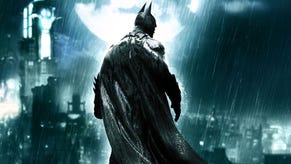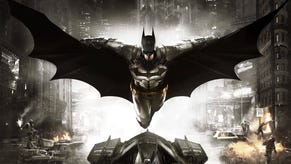Batman: Arkham Knight on PS4 is a technical tour de force
Rocksteady's superb work doesn't deserve to be overshadowed by the poor PC version.
The launch of Batman: Arkham Knight may have been blighted by the arrival of the PC train-wreck, but let's be clear - Rocksteady's console game is a slickly presented finale to the saga that should not be overlooked. Based on early impressions, the game has already proven itself in the performance stakes, and that solid frame-rate and stability is backed up by a more ambitious approach to the open world gameplay pioneered in 2011's Arkham City.
Towering above all other changes is the scale of Gotham City. At an estimated five times the size of the last game, Arkham Knight demands a rendering range not seen on older platforms. PS4 capably delivers on this too, with only minor texture pop-in when zipping between buildings - using Batman's extended range grappling hook, or driving at pace in the Batmobile. Draw distances are convincingly broad, and it's possible to even see lamplights from across the city, giving the urban sprawl a real sense of consistency as you leap from roof to roof.
Comparisons with the PS3 edition of the last game are perhaps unfair; even next to the PC release of Arkham City, the world design here is a huge step ahead in overall complexity. Gotham City arches and bends in a more organic way, from the bright pagoda gates of the Chinatown district to the neon sleaze of its downtown area - right up to the art deco spires of the city's skyscrapers. Every building is distinct thanks to a boosted polygon count across the board, eschewing the rigid layout of Arkham City for a more chaotic sprawl. And crucially, on PS4 there are no loading screens whatsoever - it's all one seamless experience from start to finish.
Gone are the black screens that separated each level from the main hub; it's now possible to move between each directly, from indoors to out. The engine streams assets in behind the scenes with nary a blip - often through smart level design - with only one hiccup noticed when approaching the Police Headquarters for the first time. It's neatly optimised for PS4, and having the game's 48GB file installed to HDD by default makes a world of difference compared to last-gen's reliance on streaming from optical disc.
Gotham City is not only more intricately detailed, but better presented in general. At a native 1920x1080 resolution, the PS4 version pushes far beyond the 1280x720 with no AA of previous console entries in the series. The crisp image is backed by a post-process anti-aliasing technique too, tackling jagged edges well in most scenarios, with the exception of a pixel-crawl effect on distant objects. As an extra, we also get filters such as film grain (noticed in the Batmobile's battle mode), plus a light chromatic aberration pass that appears along the screen's edges.
The result is a slicker, more cinematic look to Arkham Knight than was ever possible on last-gen hardware. The game also aces the last PC release via some impressive atmospheric effects, adding in heavy rainfall and rising plumes of smog across the distant city streets. Gotham City is noticeably drenched from top to bottom; unlike the light patter of snowflakes falling in Arkham City, rain weighs down heavily on Gotham with splashes and ripples on the road surface. Impressively, rain is also properly shaded by nearby lighting, tinged to whatever neon colour it passes by.
The full suite of Unreal Engine 3's post effects is brought to bear, from light shafts to bloom and a stylish lens flare. Notably, particles are ramped up in number on PS4, and each lights up the nearby environment as a batch erupts from downed tanks. Reflections also impress; though not strictly accurate to every light source's position, the approximated effect is still convincing and gives Gotham's streets a crisp, damp sheen not seen on Arkham City's simpler normal maps.
At a street level, Gotham is also amply populated. Crowd density is far from Grand Theft Auto 5's level (the city is mostly evacuated after all), but its roads are nevertheless alive with cops and robbers in chase, giving the city a sense of purpose outside of Batman's missions. Roaming tanks and gangs fill the rest of the space, often clubbing together in greater number than Arkham City's smaller pockets of enemies - again, the reported number is five times the NPC count to befit current-gen specs.
Arkham Knight's physics mark a huge upgrade for the series as a whole too. A destruction system is now put in place across the city's buildings, primarily to give the Batmobile a 'wrecking ball' effect as it clips wall edges. Pillars and building-sides crumble as it cut corners sharply as a result, a satisfying effect that has concrete chunks fly from the point of impact. On foot, Batman's cape now also boasts much-improved cloth physics via Nvidia's PhysX; each turn prompting a more nuanced whip and curl to the fabric that we also see on the city's flags.
In line with the seamless nature of the game's world, Rocksteady makes the effort to minimise the use of pre-rendered cut-scenes on PS4 in favour of keeping the action in-engine. As with the last game, there's still a reliance on video sequences to mask loading times at points - such as before and after the prologue scene in the diner. However it's now much rarer to see this trick, and as a result, gameplay seamlessly shifts into cut-scenes with single camera pans, showing off the high level of character detail during close-ups that might not have been caught in play.
All of this rattles along at a fair clip in performance, of course. What we're given on PS4 may be capped at 30fps with an adaptive v-sync, but in the visual sense we're getting results beyond what was possible in the maxed-out PC version of Arkham City (barring its anti-aliasing options). Compared to the last game on Xbox 360 and PS3, where tearing and frame-rate drops were a more regular issue, Arkham Knight's performance hiccups are relatively confined on PS4. Fast driving sections turn in the worst numbers overall, but the rest is very smooth overall.
The current controversy over the shockingly poor launch of the PC version is a terrible disappointment bearing in mind how solid the PS4 version is. Previous Rocksteady-helmed ports were worthy, accomplished pieces of work, but the outsourced Arkham Knight looks terrible to the point where reports suggest that even Titan X-equipped PCs cannot sustain 1080p60. We've only just received code, but what's immediately obvious is that even a Core i7 with a GTX 780 Ti can't sustain 60fps, even on the lowest settings.
After years in development, the controversy surrounding the terrible PC game obviously takes the shine away from what should have been a triumphant launch for Rocksteady's long-awaited trilogy closer. On PS4 at least - the only version we've tested in-depth so far - the finale to the Arkham saga is an absolute showcase. The huge scale to Gotham is just one part of what makes Arkham Knight work; the seamless movement between areas and cut-scenes, improved atmospherics and physics-based backdrops all combine to enrich the process of exploring the city. Going back to Arkham City on PS3 makes for a relatively barren, confined experience, and it's clear we needed newer hardware to bring this city - and the Batmobile in particular - to life.
Meanwhile, what of the Xbox One version? Rocksteady has turned in a gorgeous, well-optimised title on PS4, and early reports show an update is incoming to further improve its performance for the platform (assuming that those enhancements were not already part of the review code handed out to press). But for now, the resolution and frame-rate metrics on Microsoft's console remain a mystery - an enigma we hope to solve in a performance analysis once we have our hands on retail code.
























